Complex Project Management: Causes, Failures, and Drivers Analysis
VerifiedAdded on 2020/04/01
|23
|6677
|51
Report
AI Summary
This report provides a comprehensive overview of complex project management, exploring the multifaceted aspects that contribute to project success and failure. It begins by identifying the causes of project complexity, emphasizing human behavior, system interdependencies, and ambiguity. The report then delves into the failures of complex projects, highlighting communication breakdowns, decision-making challenges, and resource constraints. Key drivers of project complexity, including project scope, interactions, and context, are examined. The core of the report focuses on the five dimensions of complex project management: cost, schedule, technical aspects, context, and financing, detailing their significance and impact on project outcomes. Furthermore, the report offers insights into essential tools and techniques for project managers, critical planning methods, and the problems associated with project complexity, such as uncertainty and risk. By analyzing these factors, the report aims to provide a holistic understanding of complex project management and equip readers with strategies for effective project implementation.
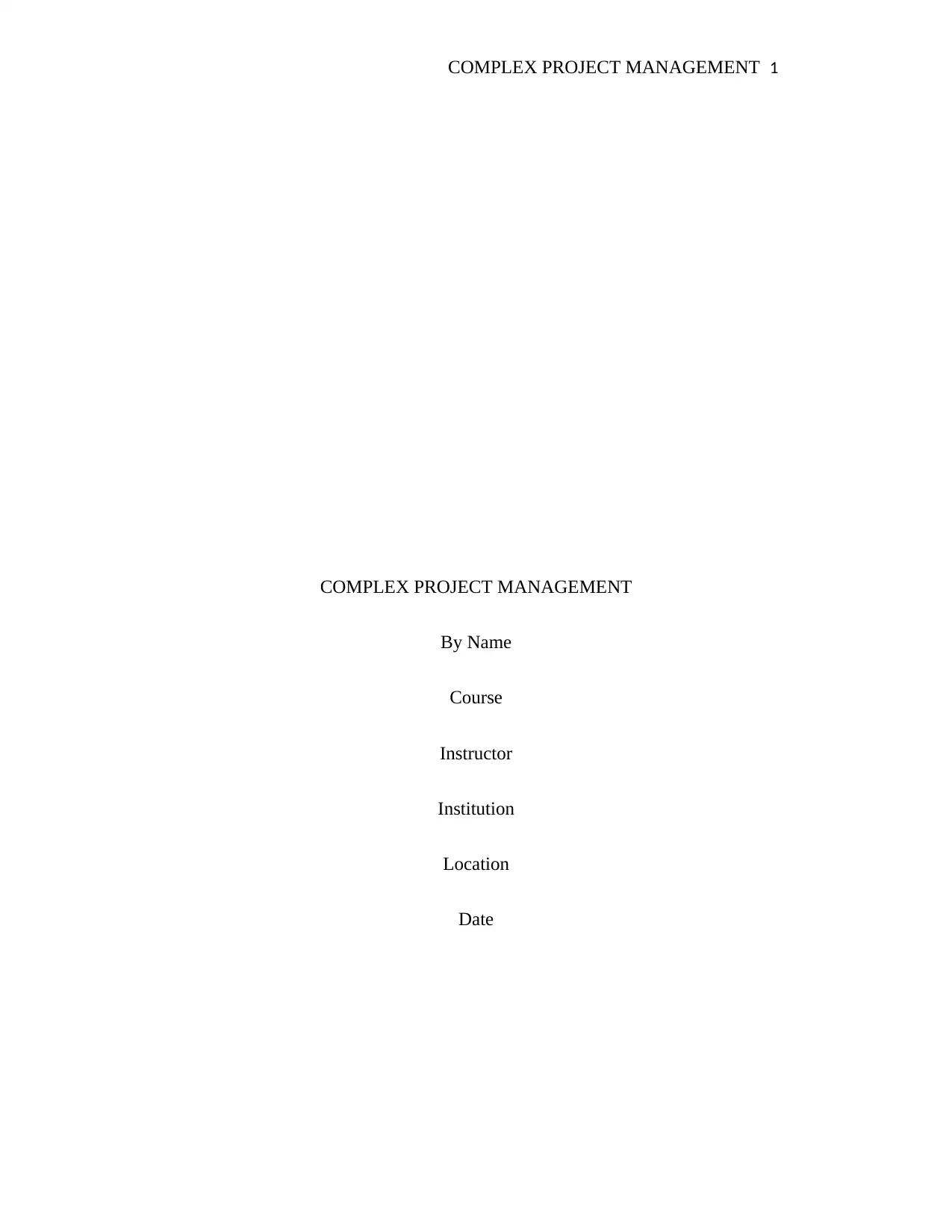
COMPLEX PROJECT MANAGEMENT 1
COMPLEX PROJECT MANAGEMENT
By Name
Course
Instructor
Institution
Location
Date
COMPLEX PROJECT MANAGEMENT
By Name
Course
Instructor
Institution
Location
Date
Paraphrase This Document
Need a fresh take? Get an instant paraphrase of this document with our AI Paraphraser
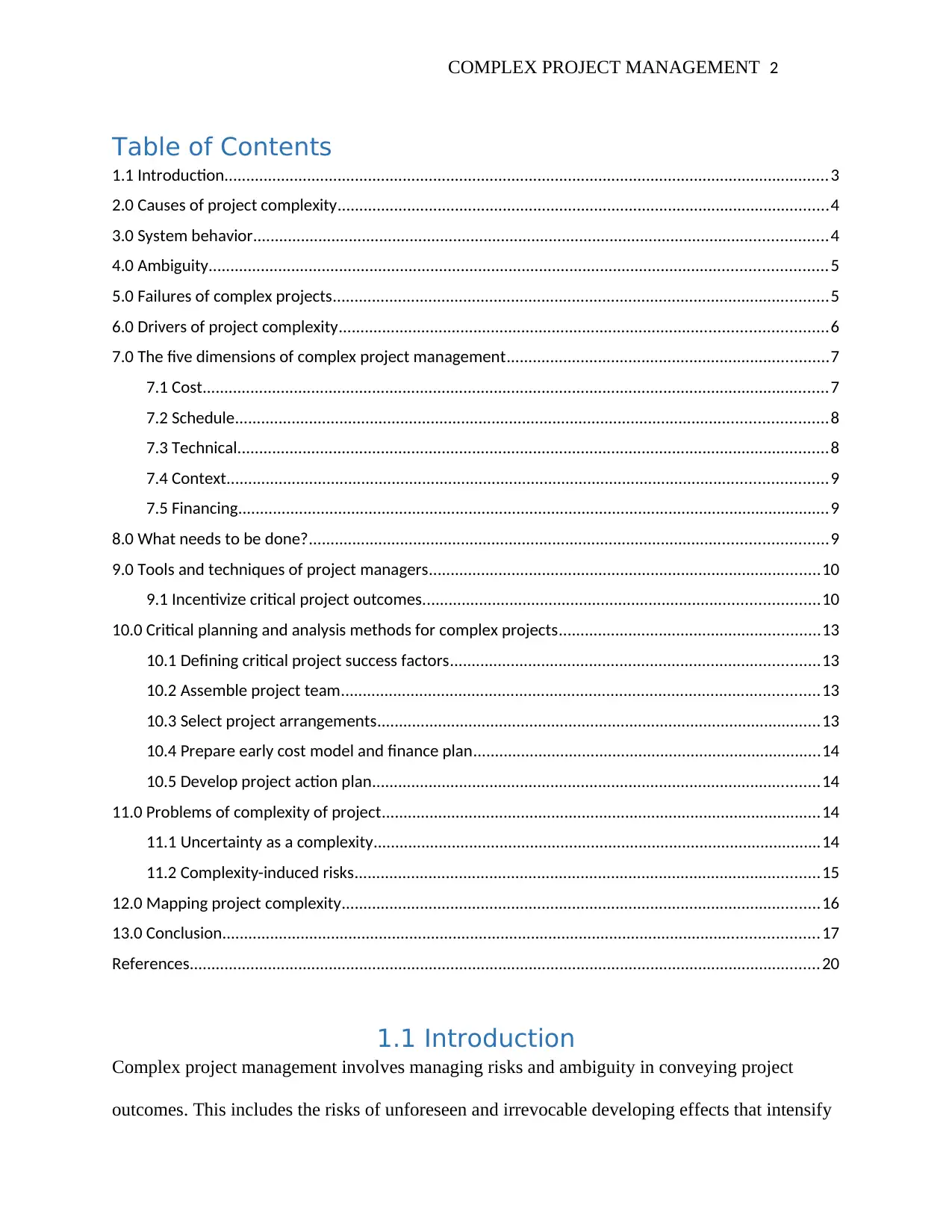
COMPLEX PROJECT MANAGEMENT 2
Table of Contents
1.1 Introduction...........................................................................................................................................3
2.0 Causes of project complexity.................................................................................................................4
3.0 System behavior....................................................................................................................................4
4.0 Ambiguity..............................................................................................................................................5
5.0 Failures of complex projects..................................................................................................................5
6.0 Drivers of project complexity................................................................................................................6
7.0 The five dimensions of complex project management..........................................................................7
7.1 Cost................................................................................................................................................7
7.2 Schedule........................................................................................................................................8
7.3 Technical........................................................................................................................................8
7.4 Context..........................................................................................................................................9
7.5 Financing........................................................................................................................................9
8.0 What needs to be done?.......................................................................................................................9
9.0 Tools and techniques of project managers..........................................................................................10
9.1 Incentivize critical project outcomes...........................................................................................10
10.0 Critical planning and analysis methods for complex projects............................................................13
10.1 Defining critical project success factors.....................................................................................13
10.2 Assemble project team..............................................................................................................13
10.3 Select project arrangements......................................................................................................13
10.4 Prepare early cost model and finance plan................................................................................14
10.5 Develop project action plan.......................................................................................................14
11.0 Problems of complexity of project.....................................................................................................14
11.1 Uncertainty as a complexity.......................................................................................................14
11.2 Complexity-induced risks...........................................................................................................15
12.0 Mapping project complexity..............................................................................................................16
13.0 Conclusion.........................................................................................................................................17
References.................................................................................................................................................20
1.1 Introduction
Complex project management involves managing risks and ambiguity in conveying project
outcomes. This includes the risks of unforeseen and irrevocable developing effects that intensify
Table of Contents
1.1 Introduction...........................................................................................................................................3
2.0 Causes of project complexity.................................................................................................................4
3.0 System behavior....................................................................................................................................4
4.0 Ambiguity..............................................................................................................................................5
5.0 Failures of complex projects..................................................................................................................5
6.0 Drivers of project complexity................................................................................................................6
7.0 The five dimensions of complex project management..........................................................................7
7.1 Cost................................................................................................................................................7
7.2 Schedule........................................................................................................................................8
7.3 Technical........................................................................................................................................8
7.4 Context..........................................................................................................................................9
7.5 Financing........................................................................................................................................9
8.0 What needs to be done?.......................................................................................................................9
9.0 Tools and techniques of project managers..........................................................................................10
9.1 Incentivize critical project outcomes...........................................................................................10
10.0 Critical planning and analysis methods for complex projects............................................................13
10.1 Defining critical project success factors.....................................................................................13
10.2 Assemble project team..............................................................................................................13
10.3 Select project arrangements......................................................................................................13
10.4 Prepare early cost model and finance plan................................................................................14
10.5 Develop project action plan.......................................................................................................14
11.0 Problems of complexity of project.....................................................................................................14
11.1 Uncertainty as a complexity.......................................................................................................14
11.2 Complexity-induced risks...........................................................................................................15
12.0 Mapping project complexity..............................................................................................................16
13.0 Conclusion.........................................................................................................................................17
References.................................................................................................................................................20
1.1 Introduction
Complex project management involves managing risks and ambiguity in conveying project
outcomes. This includes the risks of unforeseen and irrevocable developing effects that intensify
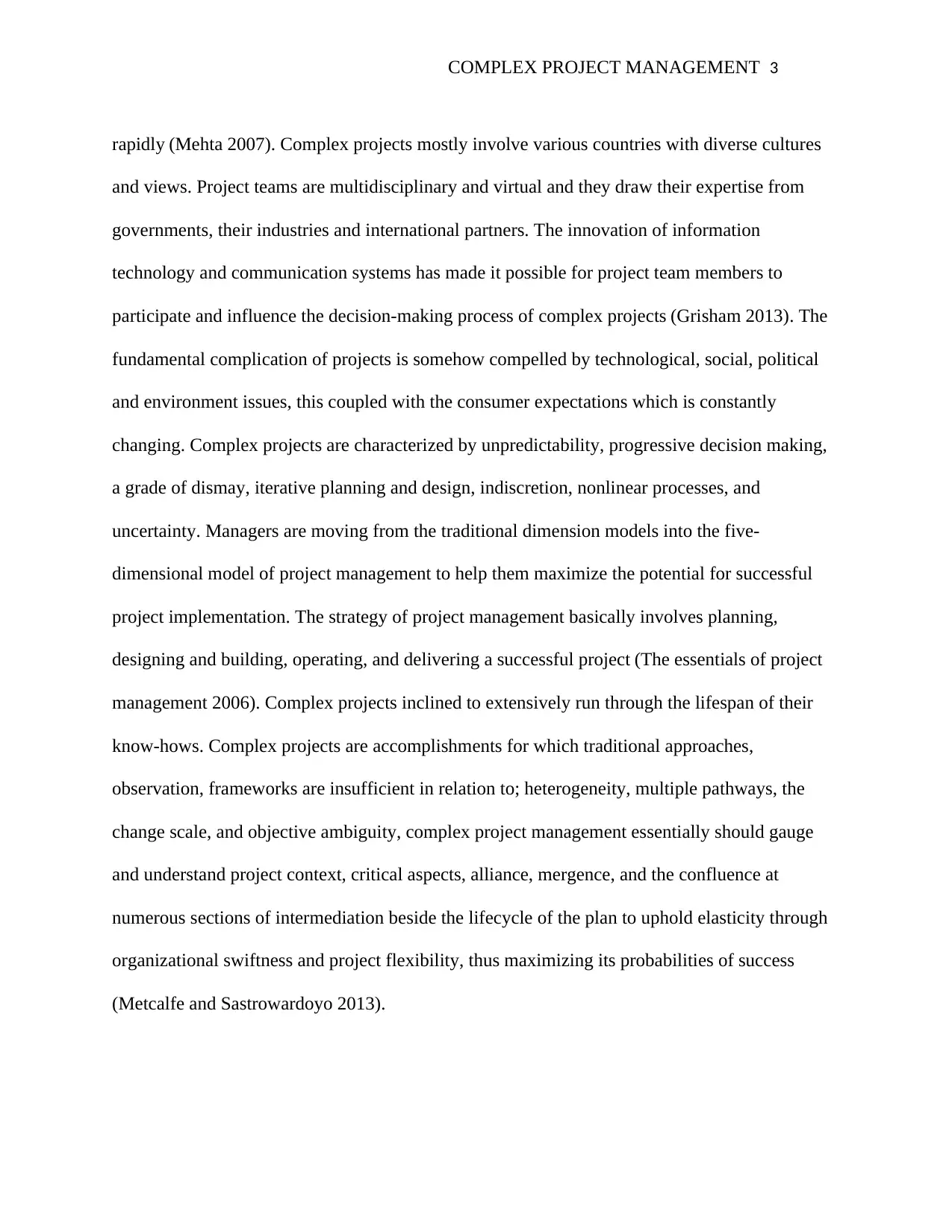
COMPLEX PROJECT MANAGEMENT 3
rapidly (Mehta 2007). Complex projects mostly involve various countries with diverse cultures
and views. Project teams are multidisciplinary and virtual and they draw their expertise from
governments, their industries and international partners. The innovation of information
technology and communication systems has made it possible for project team members to
participate and influence the decision-making process of complex projects (Grisham 2013). The
fundamental complication of projects is somehow compelled by technological, social, political
and environment issues, this coupled with the consumer expectations which is constantly
changing. Complex projects are characterized by unpredictability, progressive decision making,
a grade of dismay, iterative planning and design, indiscretion, nonlinear processes, and
uncertainty. Managers are moving from the traditional dimension models into the five-
dimensional model of project management to help them maximize the potential for successful
project implementation. The strategy of project management basically involves planning,
designing and building, operating, and delivering a successful project (The essentials of project
management 2006). Complex projects inclined to extensively run through the lifespan of their
know-hows. Complex projects are accomplishments for which traditional approaches,
observation, frameworks are insufficient in relation to; heterogeneity, multiple pathways, the
change scale, and objective ambiguity, complex project management essentially should gauge
and understand project context, critical aspects, alliance, mergence, and the confluence at
numerous sections of intermediation beside the lifecycle of the plan to uphold elasticity through
organizational swiftness and project flexibility, thus maximizing its probabilities of success
(Metcalfe and Sastrowardoyo 2013).
rapidly (Mehta 2007). Complex projects mostly involve various countries with diverse cultures
and views. Project teams are multidisciplinary and virtual and they draw their expertise from
governments, their industries and international partners. The innovation of information
technology and communication systems has made it possible for project team members to
participate and influence the decision-making process of complex projects (Grisham 2013). The
fundamental complication of projects is somehow compelled by technological, social, political
and environment issues, this coupled with the consumer expectations which is constantly
changing. Complex projects are characterized by unpredictability, progressive decision making,
a grade of dismay, iterative planning and design, indiscretion, nonlinear processes, and
uncertainty. Managers are moving from the traditional dimension models into the five-
dimensional model of project management to help them maximize the potential for successful
project implementation. The strategy of project management basically involves planning,
designing and building, operating, and delivering a successful project (The essentials of project
management 2006). Complex projects inclined to extensively run through the lifespan of their
know-hows. Complex projects are accomplishments for which traditional approaches,
observation, frameworks are insufficient in relation to; heterogeneity, multiple pathways, the
change scale, and objective ambiguity, complex project management essentially should gauge
and understand project context, critical aspects, alliance, mergence, and the confluence at
numerous sections of intermediation beside the lifecycle of the plan to uphold elasticity through
organizational swiftness and project flexibility, thus maximizing its probabilities of success
(Metcalfe and Sastrowardoyo 2013).
⊘ This is a preview!⊘
Do you want full access?
Subscribe today to unlock all pages.

Trusted by 1+ million students worldwide
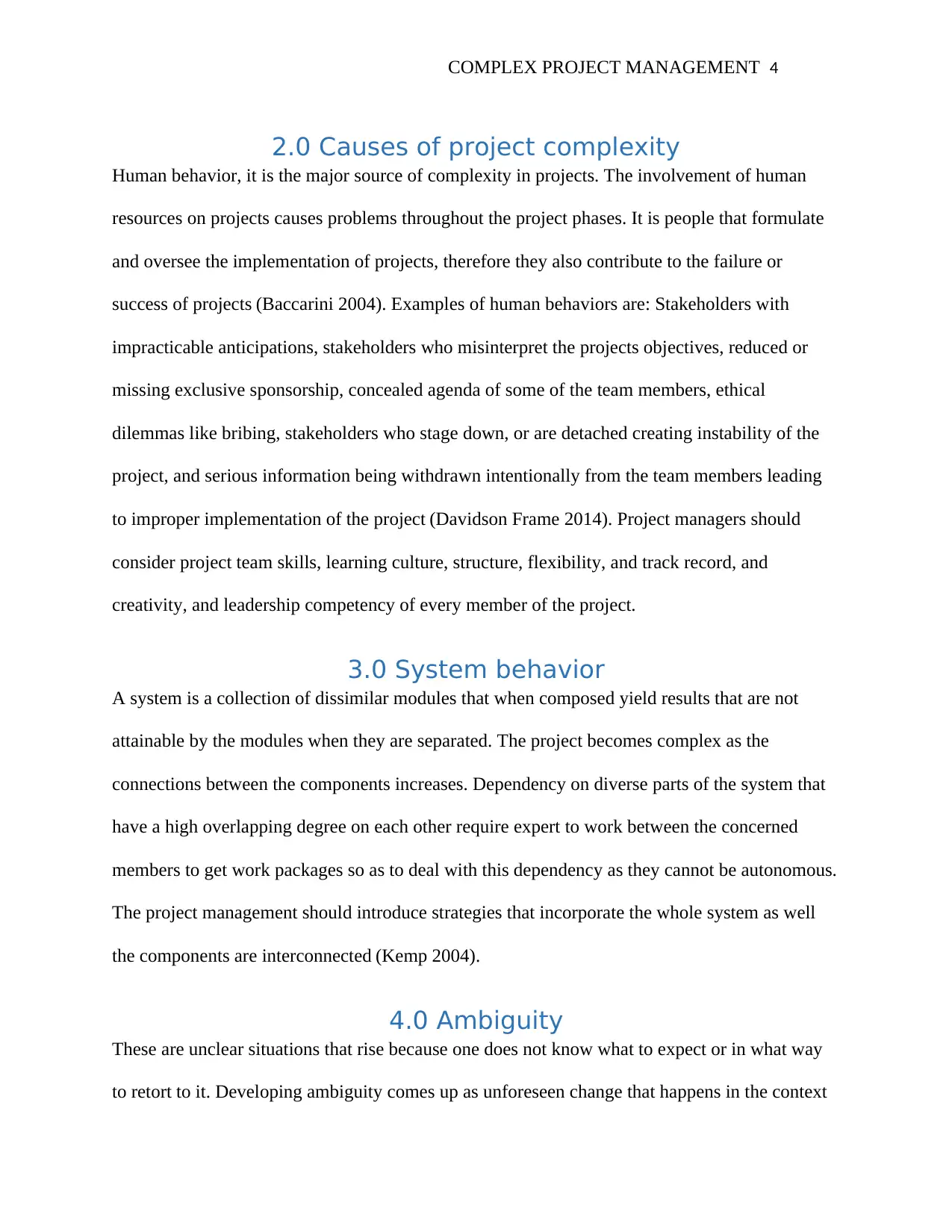
COMPLEX PROJECT MANAGEMENT 4
2.0 Causes of project complexity
Human behavior, it is the major source of complexity in projects. The involvement of human
resources on projects causes problems throughout the project phases. It is people that formulate
and oversee the implementation of projects, therefore they also contribute to the failure or
success of projects (Baccarini 2004). Examples of human behaviors are: Stakeholders with
impracticable anticipations, stakeholders who misinterpret the projects objectives, reduced or
missing exclusive sponsorship, concealed agenda of some of the team members, ethical
dilemmas like bribing, stakeholders who stage down, or are detached creating instability of the
project, and serious information being withdrawn intentionally from the team members leading
to improper implementation of the project (Davidson Frame 2014). Project managers should
consider project team skills, learning culture, structure, flexibility, and track record, and
creativity, and leadership competency of every member of the project.
3.0 System behavior
A system is a collection of dissimilar modules that when composed yield results that are not
attainable by the modules when they are separated. The project becomes complex as the
connections between the components increases. Dependency on diverse parts of the system that
have a high overlapping degree on each other require expert to work between the concerned
members to get work packages so as to deal with this dependency as they cannot be autonomous.
The project management should introduce strategies that incorporate the whole system as well
the components are interconnected (Kemp 2004).
4.0 Ambiguity
These are unclear situations that rise because one does not know what to expect or in what way
to retort to it. Developing ambiguity comes up as unforeseen change that happens in the context
2.0 Causes of project complexity
Human behavior, it is the major source of complexity in projects. The involvement of human
resources on projects causes problems throughout the project phases. It is people that formulate
and oversee the implementation of projects, therefore they also contribute to the failure or
success of projects (Baccarini 2004). Examples of human behaviors are: Stakeholders with
impracticable anticipations, stakeholders who misinterpret the projects objectives, reduced or
missing exclusive sponsorship, concealed agenda of some of the team members, ethical
dilemmas like bribing, stakeholders who stage down, or are detached creating instability of the
project, and serious information being withdrawn intentionally from the team members leading
to improper implementation of the project (Davidson Frame 2014). Project managers should
consider project team skills, learning culture, structure, flexibility, and track record, and
creativity, and leadership competency of every member of the project.
3.0 System behavior
A system is a collection of dissimilar modules that when composed yield results that are not
attainable by the modules when they are separated. The project becomes complex as the
connections between the components increases. Dependency on diverse parts of the system that
have a high overlapping degree on each other require expert to work between the concerned
members to get work packages so as to deal with this dependency as they cannot be autonomous.
The project management should introduce strategies that incorporate the whole system as well
the components are interconnected (Kemp 2004).
4.0 Ambiguity
These are unclear situations that rise because one does not know what to expect or in what way
to retort to it. Developing ambiguity comes up as unforeseen change that happens in the context
Paraphrase This Document
Need a fresh take? Get an instant paraphrase of this document with our AI Paraphraser
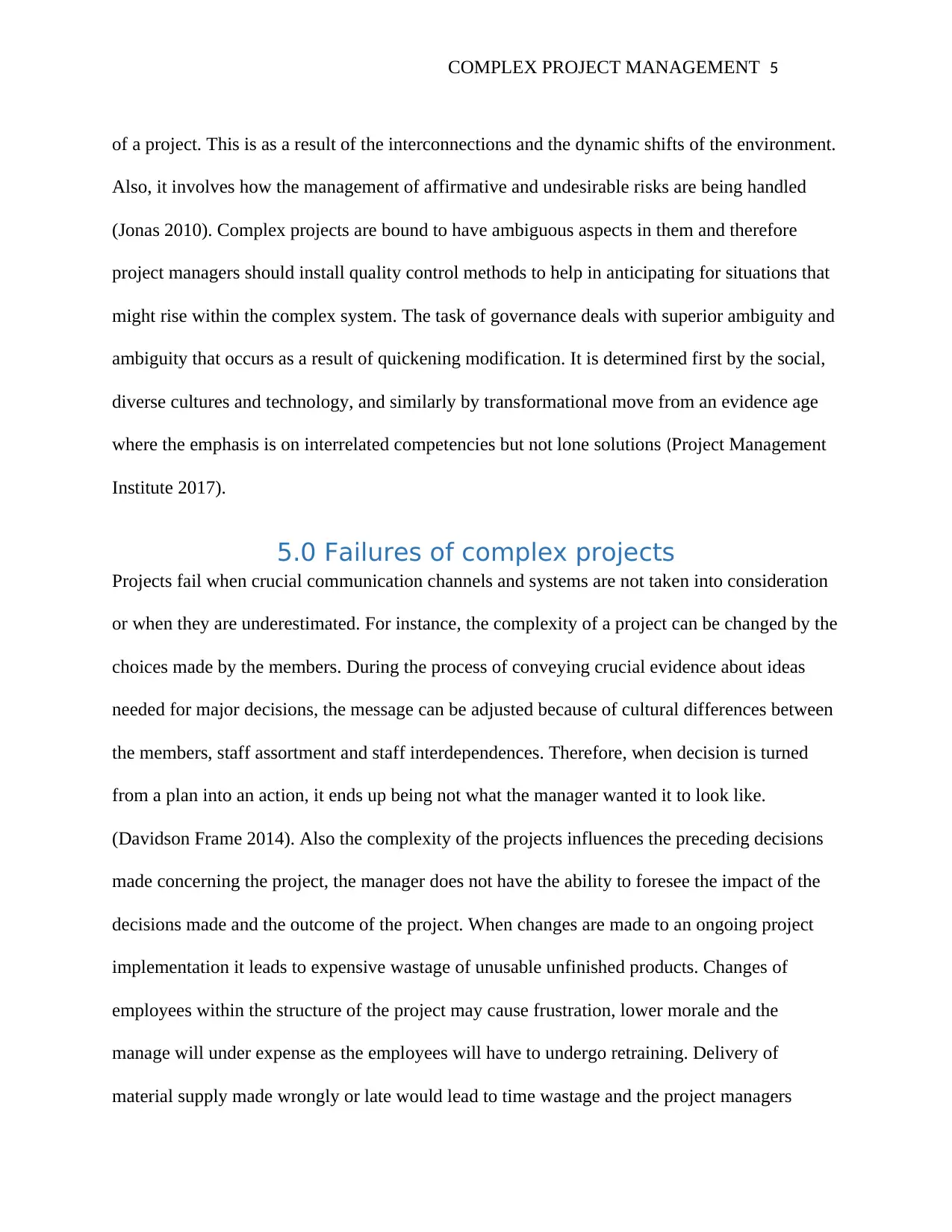
COMPLEX PROJECT MANAGEMENT 5
of a project. This is as a result of the interconnections and the dynamic shifts of the environment.
Also, it involves how the management of affirmative and undesirable risks are being handled
(Jonas 2010). Complex projects are bound to have ambiguous aspects in them and therefore
project managers should install quality control methods to help in anticipating for situations that
might rise within the complex system. The task of governance deals with superior ambiguity and
ambiguity that occurs as a result of quickening modification. It is determined first by the social,
diverse cultures and technology, and similarly by transformational move from an evidence age
where the emphasis is on interrelated competencies but not lone solutions (Project Management
Institute 2017).
5.0 Failures of complex projects
Projects fail when crucial communication channels and systems are not taken into consideration
or when they are underestimated. For instance, the complexity of a project can be changed by the
choices made by the members. During the process of conveying crucial evidence about ideas
needed for major decisions, the message can be adjusted because of cultural differences between
the members, staff assortment and staff interdependences. Therefore, when decision is turned
from a plan into an action, it ends up being not what the manager wanted it to look like.
(Davidson Frame 2014). Also the complexity of the projects influences the preceding decisions
made concerning the project, the manager does not have the ability to foresee the impact of the
decisions made and the outcome of the project. When changes are made to an ongoing project
implementation it leads to expensive wastage of unusable unfinished products. Changes of
employees within the structure of the project may cause frustration, lower morale and the
manage will under expense as the employees will have to undergo retraining. Delivery of
material supply made wrongly or late would lead to time wastage and the project managers
of a project. This is as a result of the interconnections and the dynamic shifts of the environment.
Also, it involves how the management of affirmative and undesirable risks are being handled
(Jonas 2010). Complex projects are bound to have ambiguous aspects in them and therefore
project managers should install quality control methods to help in anticipating for situations that
might rise within the complex system. The task of governance deals with superior ambiguity and
ambiguity that occurs as a result of quickening modification. It is determined first by the social,
diverse cultures and technology, and similarly by transformational move from an evidence age
where the emphasis is on interrelated competencies but not lone solutions (Project Management
Institute 2017).
5.0 Failures of complex projects
Projects fail when crucial communication channels and systems are not taken into consideration
or when they are underestimated. For instance, the complexity of a project can be changed by the
choices made by the members. During the process of conveying crucial evidence about ideas
needed for major decisions, the message can be adjusted because of cultural differences between
the members, staff assortment and staff interdependences. Therefore, when decision is turned
from a plan into an action, it ends up being not what the manager wanted it to look like.
(Davidson Frame 2014). Also the complexity of the projects influences the preceding decisions
made concerning the project, the manager does not have the ability to foresee the impact of the
decisions made and the outcome of the project. When changes are made to an ongoing project
implementation it leads to expensive wastage of unusable unfinished products. Changes of
employees within the structure of the project may cause frustration, lower morale and the
manage will under expense as the employees will have to undergo retraining. Delivery of
material supply made wrongly or late would lead to time wastage and the project managers
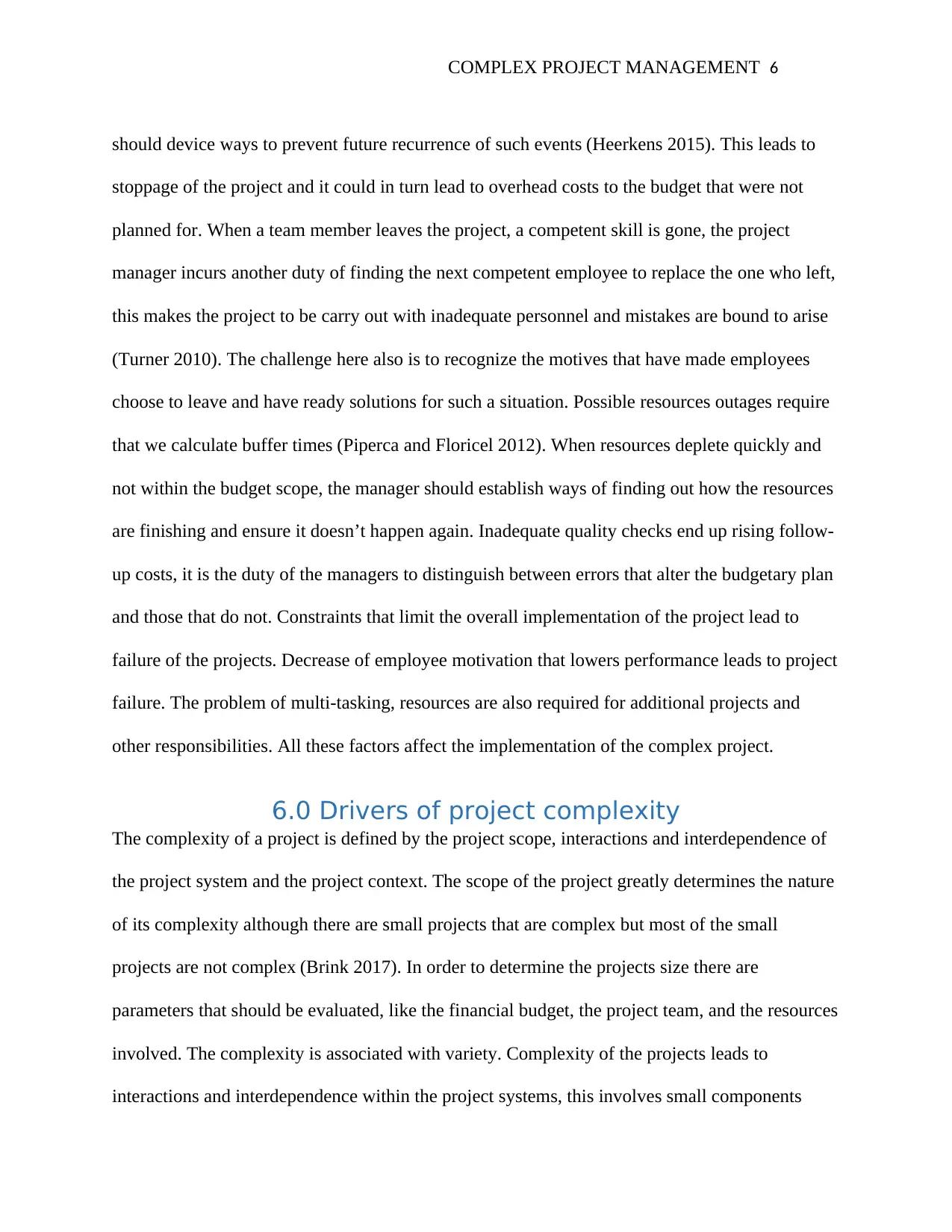
COMPLEX PROJECT MANAGEMENT 6
should device ways to prevent future recurrence of such events (Heerkens 2015). This leads to
stoppage of the project and it could in turn lead to overhead costs to the budget that were not
planned for. When a team member leaves the project, a competent skill is gone, the project
manager incurs another duty of finding the next competent employee to replace the one who left,
this makes the project to be carry out with inadequate personnel and mistakes are bound to arise
(Turner 2010). The challenge here also is to recognize the motives that have made employees
choose to leave and have ready solutions for such a situation. Possible resources outages require
that we calculate buffer times (Piperca and Floricel 2012). When resources deplete quickly and
not within the budget scope, the manager should establish ways of finding out how the resources
are finishing and ensure it doesn’t happen again. Inadequate quality checks end up rising follow-
up costs, it is the duty of the managers to distinguish between errors that alter the budgetary plan
and those that do not. Constraints that limit the overall implementation of the project lead to
failure of the projects. Decrease of employee motivation that lowers performance leads to project
failure. The problem of multi-tasking, resources are also required for additional projects and
other responsibilities. All these factors affect the implementation of the complex project.
6.0 Drivers of project complexity
The complexity of a project is defined by the project scope, interactions and interdependence of
the project system and the project context. The scope of the project greatly determines the nature
of its complexity although there are small projects that are complex but most of the small
projects are not complex (Brink 2017). In order to determine the projects size there are
parameters that should be evaluated, like the financial budget, the project team, and the resources
involved. The complexity is associated with variety. Complexity of the projects leads to
interactions and interdependence within the project systems, this involves small components
should device ways to prevent future recurrence of such events (Heerkens 2015). This leads to
stoppage of the project and it could in turn lead to overhead costs to the budget that were not
planned for. When a team member leaves the project, a competent skill is gone, the project
manager incurs another duty of finding the next competent employee to replace the one who left,
this makes the project to be carry out with inadequate personnel and mistakes are bound to arise
(Turner 2010). The challenge here also is to recognize the motives that have made employees
choose to leave and have ready solutions for such a situation. Possible resources outages require
that we calculate buffer times (Piperca and Floricel 2012). When resources deplete quickly and
not within the budget scope, the manager should establish ways of finding out how the resources
are finishing and ensure it doesn’t happen again. Inadequate quality checks end up rising follow-
up costs, it is the duty of the managers to distinguish between errors that alter the budgetary plan
and those that do not. Constraints that limit the overall implementation of the project lead to
failure of the projects. Decrease of employee motivation that lowers performance leads to project
failure. The problem of multi-tasking, resources are also required for additional projects and
other responsibilities. All these factors affect the implementation of the complex project.
6.0 Drivers of project complexity
The complexity of a project is defined by the project scope, interactions and interdependence of
the project system and the project context. The scope of the project greatly determines the nature
of its complexity although there are small projects that are complex but most of the small
projects are not complex (Brink 2017). In order to determine the projects size there are
parameters that should be evaluated, like the financial budget, the project team, and the resources
involved. The complexity is associated with variety. Complexity of the projects leads to
interactions and interdependence within the project systems, this involves small components
⊘ This is a preview!⊘
Do you want full access?
Subscribe today to unlock all pages.

Trusted by 1+ million students worldwide
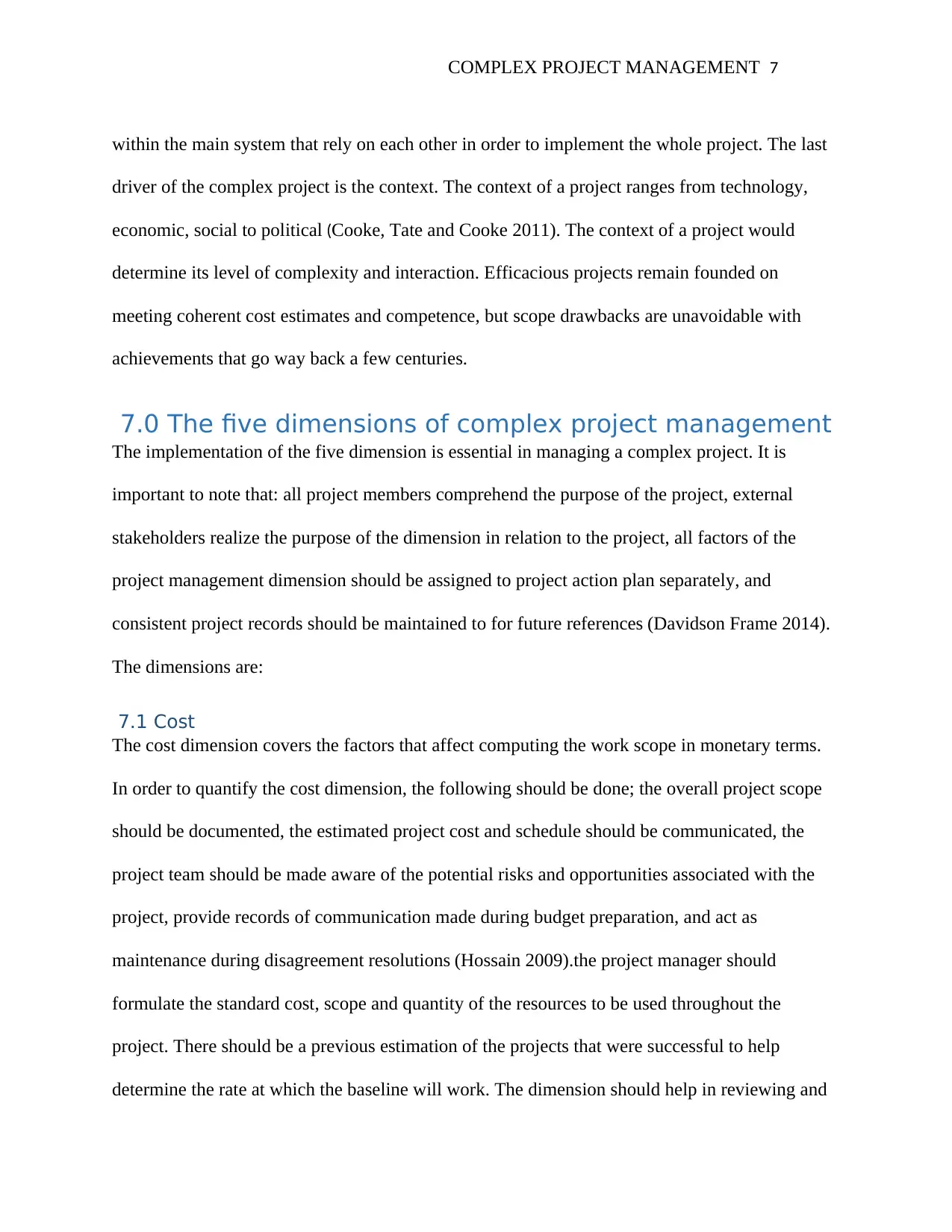
COMPLEX PROJECT MANAGEMENT 7
within the main system that rely on each other in order to implement the whole project. The last
driver of the complex project is the context. The context of a project ranges from technology,
economic, social to political (Cooke, Tate and Cooke 2011). The context of a project would
determine its level of complexity and interaction. Efficacious projects remain founded on
meeting coherent cost estimates and competence, but scope drawbacks are unavoidable with
achievements that go way back a few centuries.
7.0 The five dimensions of complex project management
The implementation of the five dimension is essential in managing a complex project. It is
important to note that: all project members comprehend the purpose of the project, external
stakeholders realize the purpose of the dimension in relation to the project, all factors of the
project management dimension should be assigned to project action plan separately, and
consistent project records should be maintained to for future references (Davidson Frame 2014).
The dimensions are:
7.1 Cost
The cost dimension covers the factors that affect computing the work scope in monetary terms.
In order to quantify the cost dimension, the following should be done; the overall project scope
should be documented, the estimated project cost and schedule should be communicated, the
project team should be made aware of the potential risks and opportunities associated with the
project, provide records of communication made during budget preparation, and act as
maintenance during disagreement resolutions (Hossain 2009).the project manager should
formulate the standard cost, scope and quantity of the resources to be used throughout the
project. There should be a previous estimation of the projects that were successful to help
determine the rate at which the baseline will work. The dimension should help in reviewing and
within the main system that rely on each other in order to implement the whole project. The last
driver of the complex project is the context. The context of a project ranges from technology,
economic, social to political (Cooke, Tate and Cooke 2011). The context of a project would
determine its level of complexity and interaction. Efficacious projects remain founded on
meeting coherent cost estimates and competence, but scope drawbacks are unavoidable with
achievements that go way back a few centuries.
7.0 The five dimensions of complex project management
The implementation of the five dimension is essential in managing a complex project. It is
important to note that: all project members comprehend the purpose of the project, external
stakeholders realize the purpose of the dimension in relation to the project, all factors of the
project management dimension should be assigned to project action plan separately, and
consistent project records should be maintained to for future references (Davidson Frame 2014).
The dimensions are:
7.1 Cost
The cost dimension covers the factors that affect computing the work scope in monetary terms.
In order to quantify the cost dimension, the following should be done; the overall project scope
should be documented, the estimated project cost and schedule should be communicated, the
project team should be made aware of the potential risks and opportunities associated with the
project, provide records of communication made during budget preparation, and act as
maintenance during disagreement resolutions (Hossain 2009).the project manager should
formulate the standard cost, scope and quantity of the resources to be used throughout the
project. There should be a previous estimation of the projects that were successful to help
determine the rate at which the baseline will work. The dimension should help in reviewing and
Paraphrase This Document
Need a fresh take? Get an instant paraphrase of this document with our AI Paraphraser
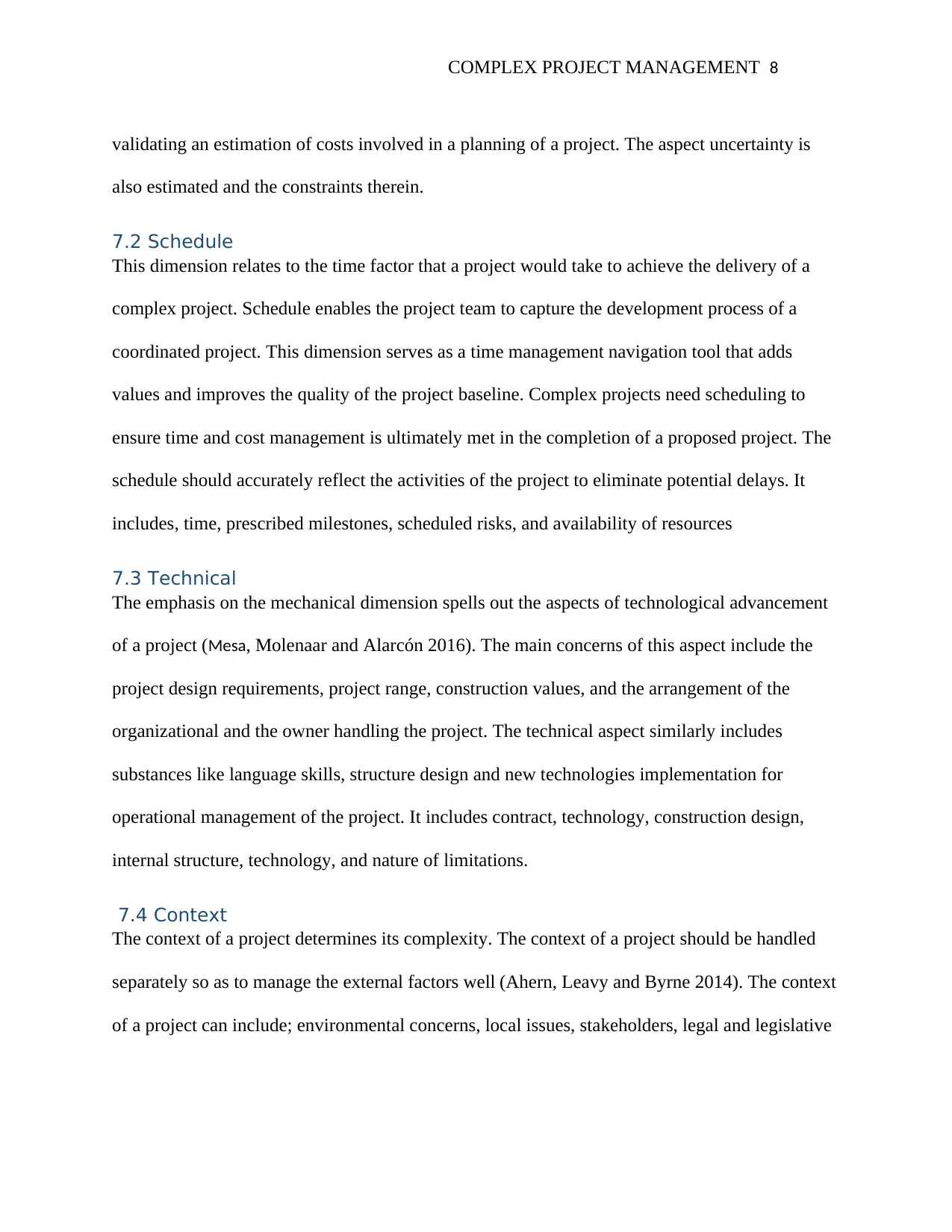
COMPLEX PROJECT MANAGEMENT 8
validating an estimation of costs involved in a planning of a project. The aspect uncertainty is
also estimated and the constraints therein.
7.2 Schedule
This dimension relates to the time factor that a project would take to achieve the delivery of a
complex project. Schedule enables the project team to capture the development process of a
coordinated project. This dimension serves as a time management navigation tool that adds
values and improves the quality of the project baseline. Complex projects need scheduling to
ensure time and cost management is ultimately met in the completion of a proposed project. The
schedule should accurately reflect the activities of the project to eliminate potential delays. It
includes, time, prescribed milestones, scheduled risks, and availability of resources
7.3 Technical
The emphasis on the mechanical dimension spells out the aspects of technological advancement
of a project (Mesa, Molenaar and Alarcón 2016). The main concerns of this aspect include the
project design requirements, project range, construction values, and the arrangement of the
organizational and the owner handling the project. The technical aspect similarly includes
substances like language skills, structure design and new technologies implementation for
operational management of the project. It includes contract, technology, construction design,
internal structure, technology, and nature of limitations.
7.4 Context
The context of a project determines its complexity. The context of a project should be handled
separately so as to manage the external factors well (Ahern, Leavy and Byrne 2014). The context
of a project can include; environmental concerns, local issues, stakeholders, legal and legislative
validating an estimation of costs involved in a planning of a project. The aspect uncertainty is
also estimated and the constraints therein.
7.2 Schedule
This dimension relates to the time factor that a project would take to achieve the delivery of a
complex project. Schedule enables the project team to capture the development process of a
coordinated project. This dimension serves as a time management navigation tool that adds
values and improves the quality of the project baseline. Complex projects need scheduling to
ensure time and cost management is ultimately met in the completion of a proposed project. The
schedule should accurately reflect the activities of the project to eliminate potential delays. It
includes, time, prescribed milestones, scheduled risks, and availability of resources
7.3 Technical
The emphasis on the mechanical dimension spells out the aspects of technological advancement
of a project (Mesa, Molenaar and Alarcón 2016). The main concerns of this aspect include the
project design requirements, project range, construction values, and the arrangement of the
organizational and the owner handling the project. The technical aspect similarly includes
substances like language skills, structure design and new technologies implementation for
operational management of the project. It includes contract, technology, construction design,
internal structure, technology, and nature of limitations.
7.4 Context
The context of a project determines its complexity. The context of a project should be handled
separately so as to manage the external factors well (Ahern, Leavy and Byrne 2014). The context
of a project can include; environmental concerns, local issues, stakeholders, legal and legislative
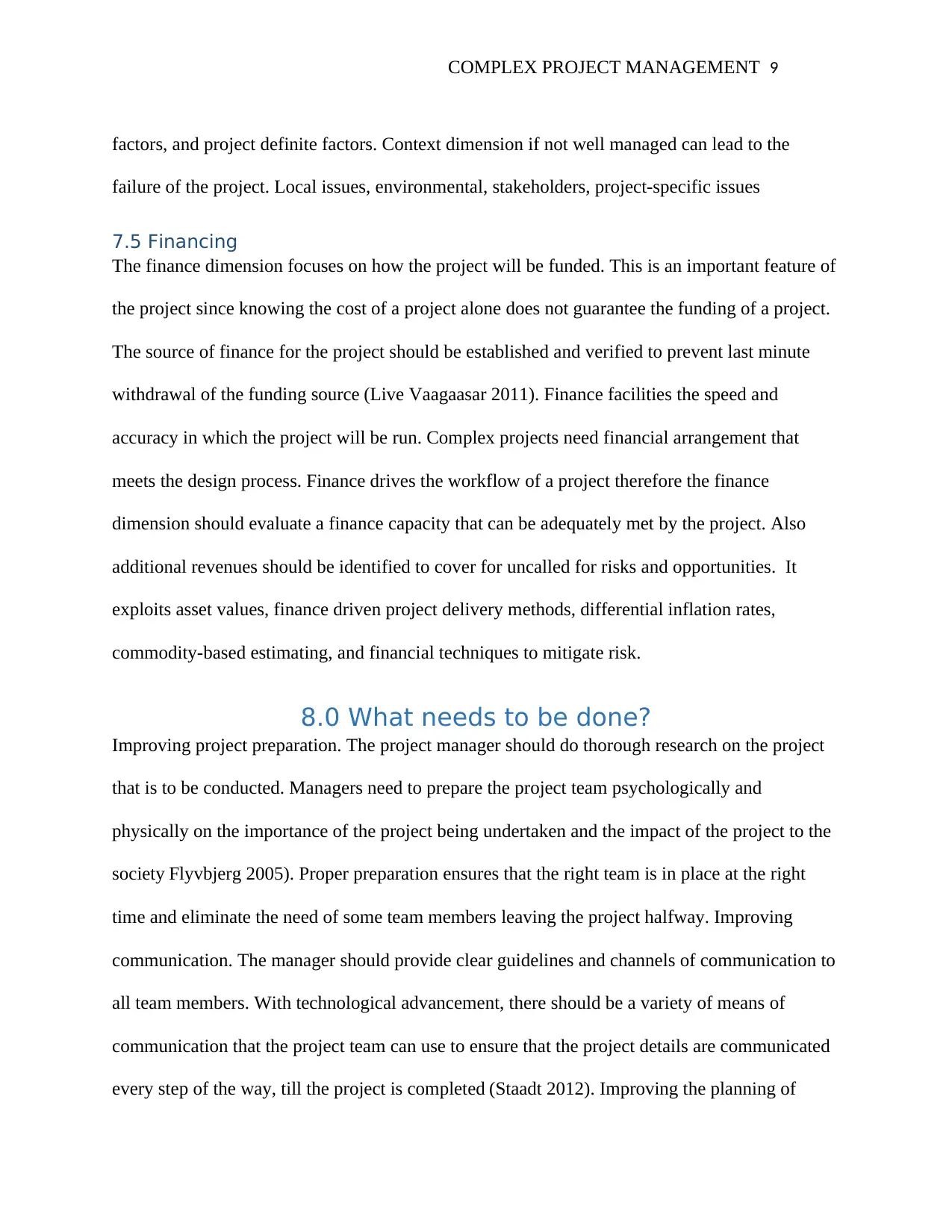
COMPLEX PROJECT MANAGEMENT 9
factors, and project definite factors. Context dimension if not well managed can lead to the
failure of the project. Local issues, environmental, stakeholders, project-specific issues
7.5 Financing
The finance dimension focuses on how the project will be funded. This is an important feature of
the project since knowing the cost of a project alone does not guarantee the funding of a project.
The source of finance for the project should be established and verified to prevent last minute
withdrawal of the funding source (Live Vaagaasar 2011). Finance facilities the speed and
accuracy in which the project will be run. Complex projects need financial arrangement that
meets the design process. Finance drives the workflow of a project therefore the finance
dimension should evaluate a finance capacity that can be adequately met by the project. Also
additional revenues should be identified to cover for uncalled for risks and opportunities. It
exploits asset values, finance driven project delivery methods, differential inflation rates,
commodity-based estimating, and financial techniques to mitigate risk.
8.0 What needs to be done?
Improving project preparation. The project manager should do thorough research on the project
that is to be conducted. Managers need to prepare the project team psychologically and
physically on the importance of the project being undertaken and the impact of the project to the
society Flyvbjerg 2005). Proper preparation ensures that the right team is in place at the right
time and eliminate the need of some team members leaving the project halfway. Improving
communication. The manager should provide clear guidelines and channels of communication to
all team members. With technological advancement, there should be a variety of means of
communication that the project team can use to ensure that the project details are communicated
every step of the way, till the project is completed (Staadt 2012). Improving the planning of
factors, and project definite factors. Context dimension if not well managed can lead to the
failure of the project. Local issues, environmental, stakeholders, project-specific issues
7.5 Financing
The finance dimension focuses on how the project will be funded. This is an important feature of
the project since knowing the cost of a project alone does not guarantee the funding of a project.
The source of finance for the project should be established and verified to prevent last minute
withdrawal of the funding source (Live Vaagaasar 2011). Finance facilities the speed and
accuracy in which the project will be run. Complex projects need financial arrangement that
meets the design process. Finance drives the workflow of a project therefore the finance
dimension should evaluate a finance capacity that can be adequately met by the project. Also
additional revenues should be identified to cover for uncalled for risks and opportunities. It
exploits asset values, finance driven project delivery methods, differential inflation rates,
commodity-based estimating, and financial techniques to mitigate risk.
8.0 What needs to be done?
Improving project preparation. The project manager should do thorough research on the project
that is to be conducted. Managers need to prepare the project team psychologically and
physically on the importance of the project being undertaken and the impact of the project to the
society Flyvbjerg 2005). Proper preparation ensures that the right team is in place at the right
time and eliminate the need of some team members leaving the project halfway. Improving
communication. The manager should provide clear guidelines and channels of communication to
all team members. With technological advancement, there should be a variety of means of
communication that the project team can use to ensure that the project details are communicated
every step of the way, till the project is completed (Staadt 2012). Improving the planning of
⊘ This is a preview!⊘
Do you want full access?
Subscribe today to unlock all pages.

Trusted by 1+ million students worldwide
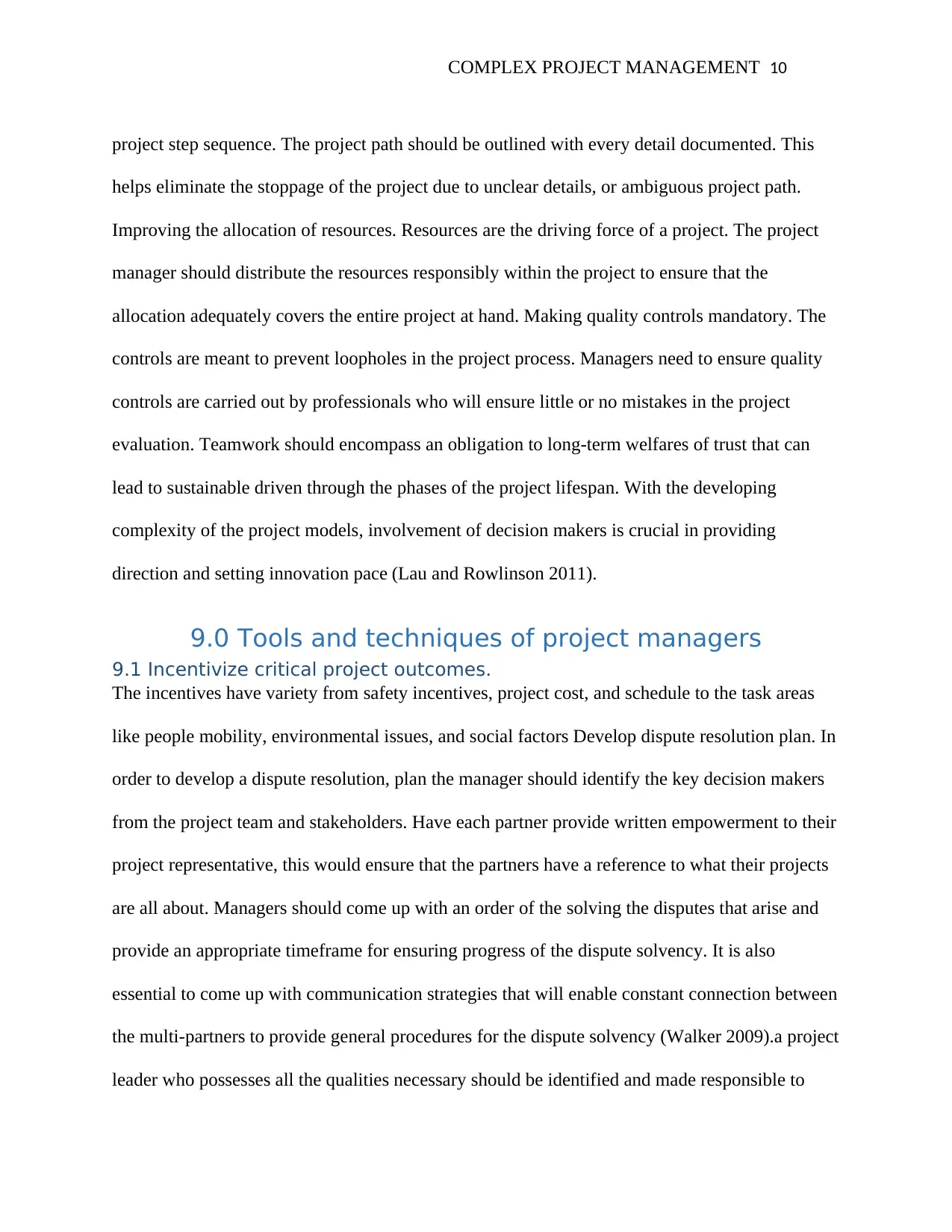
COMPLEX PROJECT MANAGEMENT 10
project step sequence. The project path should be outlined with every detail documented. This
helps eliminate the stoppage of the project due to unclear details, or ambiguous project path.
Improving the allocation of resources. Resources are the driving force of a project. The project
manager should distribute the resources responsibly within the project to ensure that the
allocation adequately covers the entire project at hand. Making quality controls mandatory. The
controls are meant to prevent loopholes in the project process. Managers need to ensure quality
controls are carried out by professionals who will ensure little or no mistakes in the project
evaluation. Teamwork should encompass an obligation to long-term welfares of trust that can
lead to sustainable driven through the phases of the project lifespan. With the developing
complexity of the project models, involvement of decision makers is crucial in providing
direction and setting innovation pace (Lau and Rowlinson 2011).
9.0 Tools and techniques of project managers
9.1 Incentivize critical project outcomes.
The incentives have variety from safety incentives, project cost, and schedule to the task areas
like people mobility, environmental issues, and social factors Develop dispute resolution plan. In
order to develop a dispute resolution, plan the manager should identify the key decision makers
from the project team and stakeholders. Have each partner provide written empowerment to their
project representative, this would ensure that the partners have a reference to what their projects
are all about. Managers should come up with an order of the solving the disputes that arise and
provide an appropriate timeframe for ensuring progress of the dispute solvency. It is also
essential to come up with communication strategies that will enable constant connection between
the multi-partners to provide general procedures for the dispute solvency (Walker 2009).a project
leader who possesses all the qualities necessary should be identified and made responsible to
project step sequence. The project path should be outlined with every detail documented. This
helps eliminate the stoppage of the project due to unclear details, or ambiguous project path.
Improving the allocation of resources. Resources are the driving force of a project. The project
manager should distribute the resources responsibly within the project to ensure that the
allocation adequately covers the entire project at hand. Making quality controls mandatory. The
controls are meant to prevent loopholes in the project process. Managers need to ensure quality
controls are carried out by professionals who will ensure little or no mistakes in the project
evaluation. Teamwork should encompass an obligation to long-term welfares of trust that can
lead to sustainable driven through the phases of the project lifespan. With the developing
complexity of the project models, involvement of decision makers is crucial in providing
direction and setting innovation pace (Lau and Rowlinson 2011).
9.0 Tools and techniques of project managers
9.1 Incentivize critical project outcomes.
The incentives have variety from safety incentives, project cost, and schedule to the task areas
like people mobility, environmental issues, and social factors Develop dispute resolution plan. In
order to develop a dispute resolution, plan the manager should identify the key decision makers
from the project team and stakeholders. Have each partner provide written empowerment to their
project representative, this would ensure that the partners have a reference to what their projects
are all about. Managers should come up with an order of the solving the disputes that arise and
provide an appropriate timeframe for ensuring progress of the dispute solvency. It is also
essential to come up with communication strategies that will enable constant connection between
the multi-partners to provide general procedures for the dispute solvency (Walker 2009).a project
leader who possesses all the qualities necessary should be identified and made responsible to
Paraphrase This Document
Need a fresh take? Get an instant paraphrase of this document with our AI Paraphraser
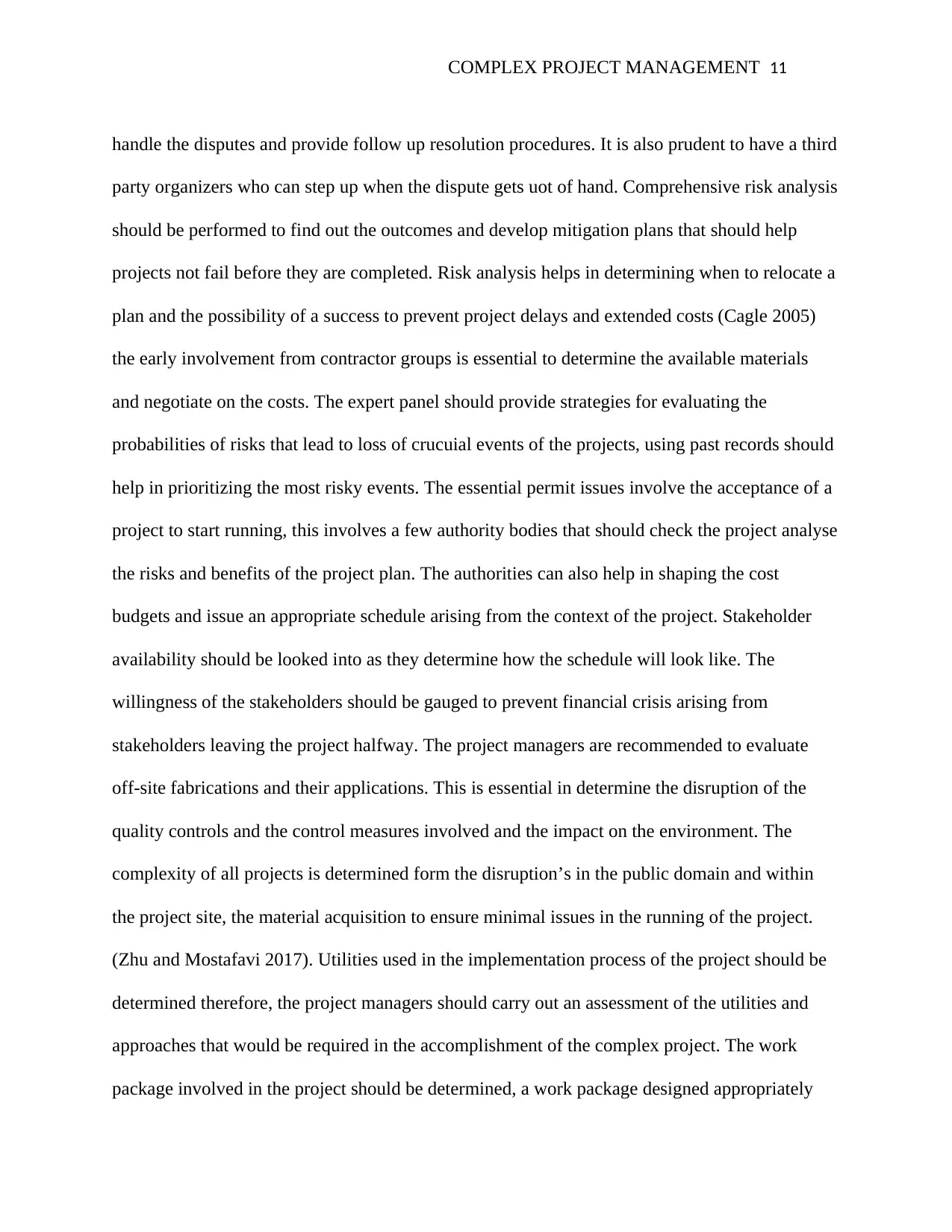
COMPLEX PROJECT MANAGEMENT 11
handle the disputes and provide follow up resolution procedures. It is also prudent to have a third
party organizers who can step up when the dispute gets uot of hand. Comprehensive risk analysis
should be performed to find out the outcomes and develop mitigation plans that should help
projects not fail before they are completed. Risk analysis helps in determining when to relocate a
plan and the possibility of a success to prevent project delays and extended costs (Cagle 2005)
the early involvement from contractor groups is essential to determine the available materials
and negotiate on the costs. The expert panel should provide strategies for evaluating the
probabilities of risks that lead to loss of crucuial events of the projects, using past records should
help in prioritizing the most risky events. The essential permit issues involve the acceptance of a
project to start running, this involves a few authority bodies that should check the project analyse
the risks and benefits of the project plan. The authorities can also help in shaping the cost
budgets and issue an appropriate schedule arising from the context of the project. Stakeholder
availability should be looked into as they determine how the schedule will look like. The
willingness of the stakeholders should be gauged to prevent financial crisis arising from
stakeholders leaving the project halfway. The project managers are recommended to evaluate
off-site fabrications and their applications. This is essential in determine the disruption of the
quality controls and the control measures involved and the impact on the environment. The
complexity of all projects is determined form the disruption’s in the public domain and within
the project site, the material acquisition to ensure minimal issues in the running of the project.
(Zhu and Mostafavi 2017). Utilities used in the implementation process of the project should be
determined therefore, the project managers should carry out an assessment of the utilities and
approaches that would be required in the accomplishment of the complex project. The work
package involved in the project should be determined, a work package designed appropriately
handle the disputes and provide follow up resolution procedures. It is also prudent to have a third
party organizers who can step up when the dispute gets uot of hand. Comprehensive risk analysis
should be performed to find out the outcomes and develop mitigation plans that should help
projects not fail before they are completed. Risk analysis helps in determining when to relocate a
plan and the possibility of a success to prevent project delays and extended costs (Cagle 2005)
the early involvement from contractor groups is essential to determine the available materials
and negotiate on the costs. The expert panel should provide strategies for evaluating the
probabilities of risks that lead to loss of crucuial events of the projects, using past records should
help in prioritizing the most risky events. The essential permit issues involve the acceptance of a
project to start running, this involves a few authority bodies that should check the project analyse
the risks and benefits of the project plan. The authorities can also help in shaping the cost
budgets and issue an appropriate schedule arising from the context of the project. Stakeholder
availability should be looked into as they determine how the schedule will look like. The
willingness of the stakeholders should be gauged to prevent financial crisis arising from
stakeholders leaving the project halfway. The project managers are recommended to evaluate
off-site fabrications and their applications. This is essential in determine the disruption of the
quality controls and the control measures involved and the impact on the environment. The
complexity of all projects is determined form the disruption’s in the public domain and within
the project site, the material acquisition to ensure minimal issues in the running of the project.
(Zhu and Mostafavi 2017). Utilities used in the implementation process of the project should be
determined therefore, the project managers should carry out an assessment of the utilities and
approaches that would be required in the accomplishment of the complex project. The work
package involved in the project should be determined, a work package designed appropriately
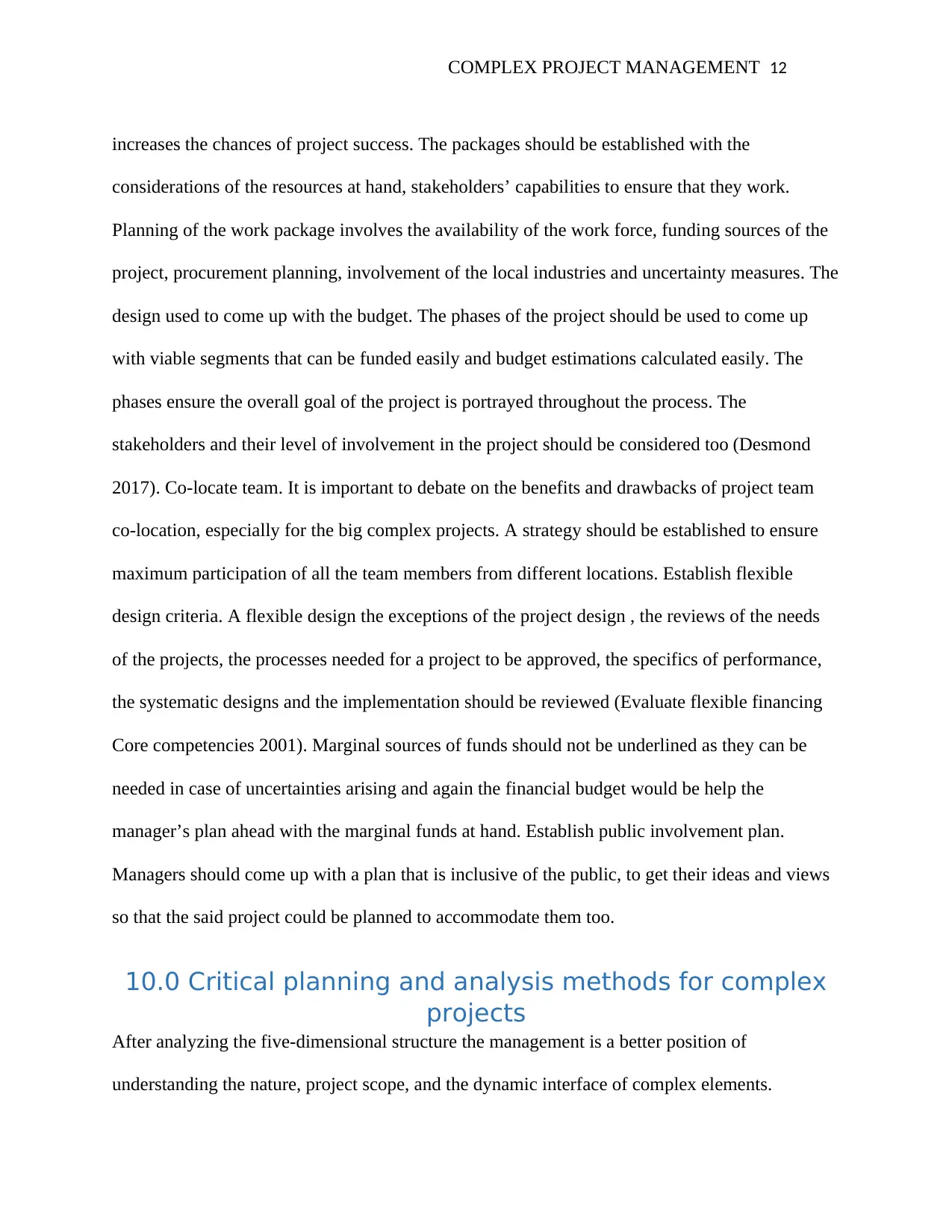
COMPLEX PROJECT MANAGEMENT 12
increases the chances of project success. The packages should be established with the
considerations of the resources at hand, stakeholders’ capabilities to ensure that they work.
Planning of the work package involves the availability of the work force, funding sources of the
project, procurement planning, involvement of the local industries and uncertainty measures. The
design used to come up with the budget. The phases of the project should be used to come up
with viable segments that can be funded easily and budget estimations calculated easily. The
phases ensure the overall goal of the project is portrayed throughout the process. The
stakeholders and their level of involvement in the project should be considered too (Desmond
2017). Co-locate team. It is important to debate on the benefits and drawbacks of project team
co-location, especially for the big complex projects. A strategy should be established to ensure
maximum participation of all the team members from different locations. Establish flexible
design criteria. A flexible design the exceptions of the project design , the reviews of the needs
of the projects, the processes needed for a project to be approved, the specifics of performance,
the systematic designs and the implementation should be reviewed (Evaluate flexible financing
Core competencies 2001). Marginal sources of funds should not be underlined as they can be
needed in case of uncertainties arising and again the financial budget would be help the
manager’s plan ahead with the marginal funds at hand. Establish public involvement plan.
Managers should come up with a plan that is inclusive of the public, to get their ideas and views
so that the said project could be planned to accommodate them too.
10.0 Critical planning and analysis methods for complex
projects
After analyzing the five-dimensional structure the management is a better position of
understanding the nature, project scope, and the dynamic interface of complex elements.
increases the chances of project success. The packages should be established with the
considerations of the resources at hand, stakeholders’ capabilities to ensure that they work.
Planning of the work package involves the availability of the work force, funding sources of the
project, procurement planning, involvement of the local industries and uncertainty measures. The
design used to come up with the budget. The phases of the project should be used to come up
with viable segments that can be funded easily and budget estimations calculated easily. The
phases ensure the overall goal of the project is portrayed throughout the process. The
stakeholders and their level of involvement in the project should be considered too (Desmond
2017). Co-locate team. It is important to debate on the benefits and drawbacks of project team
co-location, especially for the big complex projects. A strategy should be established to ensure
maximum participation of all the team members from different locations. Establish flexible
design criteria. A flexible design the exceptions of the project design , the reviews of the needs
of the projects, the processes needed for a project to be approved, the specifics of performance,
the systematic designs and the implementation should be reviewed (Evaluate flexible financing
Core competencies 2001). Marginal sources of funds should not be underlined as they can be
needed in case of uncertainties arising and again the financial budget would be help the
manager’s plan ahead with the marginal funds at hand. Establish public involvement plan.
Managers should come up with a plan that is inclusive of the public, to get their ideas and views
so that the said project could be planned to accommodate them too.
10.0 Critical planning and analysis methods for complex
projects
After analyzing the five-dimensional structure the management is a better position of
understanding the nature, project scope, and the dynamic interface of complex elements.
⊘ This is a preview!⊘
Do you want full access?
Subscribe today to unlock all pages.

Trusted by 1+ million students worldwide
1 out of 23
Related Documents
Your All-in-One AI-Powered Toolkit for Academic Success.
+13062052269
info@desklib.com
Available 24*7 on WhatsApp / Email
![[object Object]](/_next/static/media/star-bottom.7253800d.svg)
Unlock your academic potential
Copyright © 2020–2025 A2Z Services. All Rights Reserved. Developed and managed by ZUCOL.




